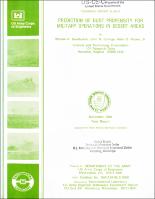Please use this identifier to cite or link to this item:
https://hdl.handle.net/11681/25797Full metadata record
| DC Field | Value | Language |
|---|---|---|
| dc.contributor.author | Dornbusch, William K. | - |
| dc.contributor.author | Strange, John N. | - |
| dc.contributor.author | Rooke, Allen D. | - |
| dc.date.accessioned | 2017-12-08T19:26:58Z | - |
| dc.date.available | 2017-12-08T19:26:58Z | - |
| dc.date.issued | 1988-11 | - |
| dc.identifier.uri | http://hdl.handle.net/11681/25797 | - |
| dc.description.abstract | A study of desert terrain was undertaken to develop a methodology suitable for prediction of dust propensity. The study focused on Yuma Proving Ground (YPG), a part of the Sonoran Desert, as an aid in developing and illustrating the methodology. Geological landforms were identified and characterized by age and geomorphic processes, and residual fine materials (clays and silts) were predicted as percent by weight for the top 10-cm soil layer. Using a data base of previous vehicular dust trails at Fort Carson, Colo., and White Sands Missile Range, NM, a functional equation for dust emission by tracked vehicles was formulated, and an emission equation was developed by means of dimensional analysis. Using this equation and the dust-propensity predictions for YPG, tracked vehicle dust emissions were predicted. | en_US |
| dc.description.sponsorship | Science and Technology Corporation (Hampton, Va.) | en_US |
| dc.language.iso | en | en_US |
| dc.publisher | Environmental Laboratory (U.S.) | en_US |
| dc.publisher | U.S. Army Engineer Waterways Experiment Station. | en_US |
| dc.relation.ispartofseries | Technical Report;EL-88-17 | - |
| dc.subject | Dust | en_US |
| dc.subject | Deserts | en_US |
| dc.title | Prediction of dust propensity for military operations in desert areas | en_US |
| dc.type | Report | en_US |
| Appears in Collections: | Technical Report | |
Files in This Item:
| File | Description | Size | Format | |
|---|---|---|---|---|
| TR EL-88-17.pdf | 10.95 MB | Adobe PDF |  View/Open |